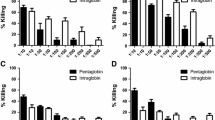Abstract
The interaction betweenPseudomonas aeruginosa strains (6 non-mucoid and 4 mucoid strains), serum factors and phagocytic cells was investigated. Strains were incubated in different concentrations of normal serum, chelated serum (with only the alternative complement pathway intact), IgG, Cls, C2 and C3 deficient serum and immune serum. After incubation complement consumption, C3 fixation and phagocytosis by polymorphonuclear leukocytes (PMN) were measured. In contrast to normal serum, immune serum raised against a mucoid and a non-mucoid strain exhibited heat-stable opsonic activity. All tenPseudomonas aeruginosa strains were able to activate complement in 20 % normal serum, leading to deposition of the activated form of the third complement component on the bacterial cell wall and to subsequent recognition and phagocytosis. One mucoid and four non-mucoid strains activated the alternative complement pathway and were effectively opsonized in chelated or in Cls, C2 or IgG deficient serum. Although mucoid strains were less able to activate complement via the alternative route, no differences were observed in opsonic requirements and phagocytosis between mucoid and non-mucoid strains.
Similar content being viewed by others
References
Peterson, P. K.: Host defense againstPseudo monas aeruginosa. In: Sabath, L. D. (ed.):Pseudomonas aeruginosa, the organism, diseases, it causes and their treatment. Hans Huber, Bern, 1980, p. 103–118.
Tapper, M. L., Armstrong, D.: Bacteremia due toPseudomonas aeruginosa complicating neoplastic disease. Journal of Infectious Diseases 1974, 130, Supplement: 14–23.
Whitecar, J. P., Luna, M., Bodey, G. P.: Pseudomonas bacteremia in patients with malignant disease. American Journal of Medical Sciences 1970, 260: 216–223.
Young, L. S., Armstrong, D.: Human immunity toPseudomonas aeruginosa. I. In vitro interaction of bacteria, polymorphonuclear leukocytes, and serum factors. Journal of Infectious Diseases 1972, 126: 257–276.
Peterson, P. K., Kim, Y., Schmeling, S., Lindeman, M., Verhoef, J., Quie, P. G.: Complement-mediated phagocytosis ofPseudomonas aeruginosa. Journal of Laboratory and Clinical Medicine 1978, 92: 883–894.
Høiby, N., Olling, S.:Pseudomonas aeruginosa infection in cystic fibrosis. Bactericidal effect of serum from normal individuals and patients with cystic fibrosis onPseudomonas aeruginosa strains from patients with fibrosis or other diseases. Acta Pathologica et Microbiologica Scandinivica (C) 1977, 85: 107–114.
Baltimore, R. S., Mitchell, M.: Immunologic investigations of mucoid strains ofPseudomonas aeruginosa: comparison of susceptibility to opsonic antibody in mucoid and non-mucoid strains. Journal of Infectious Diseases 1975, 141: 238–247.
Sokol, P. A., Ohman, D. E., Iglewski, B. H.: A more sensitive plate assay for detection of protease production ofPseudomonas aeruginosa. Journal of Clinical Microbiology 1979, 9: 538–540.
Habs, I.: Untersuchungen über die O-Antigenie vonPseudomonas aeruginosa. Zeitschrift für Hygiene und Infektions-Krankheiten 1957, 144: 218–228.
Verburgh, H. A., van Dijk, W. C., Peters, R., van der Tol, M. E., Peterson, P. K., Verhoef, J.:Stahylococcus aureus opsonization mediated via the classical and alternative pathways: a kinetic study using MgEGTA chelated serum and human sera deficient in IgG and complement factors Cls and C2. Immunology 1979, 36: 391–397.
Pondman, K. W., Hannema, A., Cormane, R., Stoop, J. W.: Unusual complement deficiency in a girl with disseminated lupus erythematosus. Nederlands Tijdschrift Geneeskunde 1969, 113: 1462–1469.
Verhoef, J., Peterson, P. K., Quie, P. G.: Kinetics of staphylococcal opsonization, attachment, ingestion and killing by human polymorphonuclear leukocytes: a quantitative assay using3H-thymidine labeled bacteria. Journal of Immunological Methods 1977, 14: 300–311.
Winkelstein, J. A., Tomasz, A.: Activation of the alternative complement pathway by pneumococcal cell wall teichoic acid. Journal of Immunology 1978, 120: 174–178.
Pennington, J. E.: Lipopolysaccharide pseudomonas vaccine: efficacy against pulmonary infection withPseudomonas aeruginosa. Journal of Infectious Diseases 1979, 140: 73–80.
Lynn, M., Sensakovic, J. W., Bartell, P. F.: In vivo distribution ofPseudomonas aeruginosa slime glycolipoprotein: association with leukocytes. Infection and Immunity 1977, 15: 109–114.
Sensakovic, J. W., Bartell, P. F.: The slime ofPseudomonas aeruginosa: biological characterization and possible role in experimental infection. Journal of Infectious Diseases 1974, 129: 101–109.
Author information
Authors and Affiliations
Additional information
This paper is part of a DSc thesis to be submitted to the Senate of the Technion Israel Institute of Technology, Haifa, Israel.
Rights and permissions
About this article
Cite this article
Meshulam, T., Verbrugh, H.A. & Verhoef, J. Opsonization and phagocytosis of mucoid and non-mucoidPseudomonas aeruginosa strains. Eur. J, Clin. Microbiol. 1, 112–117 (1982). https://doi.org/10.1007/BF02014202
Issue Date:
DOI: https://doi.org/10.1007/BF02014202




